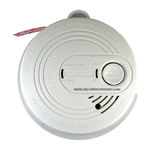
• THERE ARE TWO BASIC SMOKE ALARM TYPES - IONIZATION AND PHOTOELECTRIC.
Ionization smoke alarms (such as this smoke alarm) are your best overall choice for reliability
and fast response time, since they quickly sense small "invisible" smoke particles and will
also sense larger "visible" smoke particles. Photoelectric smoke alarms may respond more
quickly in certain types of fires, for example - slow smoldering fires with large "visible" smoke
particles. ALL TYPES OF SMOKE ALARMS HAVE LIMITATIONS. NO TYPE OF SMOKE
ALARM CAN SENSE EVERY KIND OF FIRE OR SMOKE EVERY TIME.
• SMOKE ALARMS can sound an alarm only when smoke reaches their sensors. Smoke may
not reach the smoke alarm QUICKLY ENOUGH to ensure safe escape. They do not sense
heat, flame or gas (propane).
• ALL alarms have limitations. This combination smoke/CO alarm is not foolproof and is not
warranted to protect lives or property. It is not a substitute for insurance.
• WARNING - SINCE A SMOKE OR CO ALARM WILL NOT WORK WITHOUT POWER, having an
alarm(s) that works from two completely different power sources, such as an AC direct wire with
battery backup can give you an extra measure of protection in case of an AC power failure or a dead
• CO ALARMS are designed to detect carbon monoxide gas from any source of combustion
that reaches their sensor. They are NOT designed to detect any other type of gas.
• USING A SMOKE ALARM IN A SMOKY AREA LIKE A KITCHEN, OR IN A HIGH HUMIDITY
AREA NEAR A SHOWER, CAN CAUSE FALSE ALARMS. DO NOT TURN OFF THE AC
POWER TO QUIET THE ALARM. A SMOKE ALARM WILL NOT HELP PROTECT YOU IF IT
IS NOT POWERED. Properly locate your alarm to avoid nuisance alarms.
• A SMOKE ALARM MAY NOT ALWAYS WARN YOU ABOUT FIRES CAUSED BY
CARELESSNESS AND SAFETY HAZARDS LIKE SMOKING IN BED, VIOLENT
EXPLOSIONS, ESCAPING GAS, IMPROPER STORAGE OF FLAMMABLE MATERIALS,
OVERLOADED ELECTRICAL CIRCUITS, CHILDREN PLAYING WITH MATCHES, NATURAL
CAUSES SUCH AS LIGHTNING, OR ARSON. FIRE PREVENTION IS YOUR BEST
• SMOKE ALARMS CANNOT DETECT FIRES IF THE SMOKE DOES NOT REACH THEM.
Smoke from fires may not reach the sensing chamber and set off the alarm. One unit should
be installed inside each bedroom or sleeping area.
• SMOKE ALARMS MAY NOT DETECT FIRE ON ANOTHER FLOOR OR AREA OF THE
HOME. Recommended minimum protection is at least one unit in every sleeping area and
every bedroom on every level of your home. Interconnected units may provide earlier warning
than stand-alone units since all units alarm when one detects smoke.
• ALARMS MAY NOT BE HEARD. The alarm horn in this unit meets or exceeds current
standards, but it may not be heard if: (1) the unit is located outside a closed or partially closed
door; (2) residents recently consumed alcohol or drugs; (3) the alarm is drowned out by noise
from stereos, TV's, air conditioners or other appliances or (4) if residents are hearing impaired
or sound sleepers.
• Because it is possible for the alarm to fail at any time, you must test the alarm weekly and
replace it every 5 years.